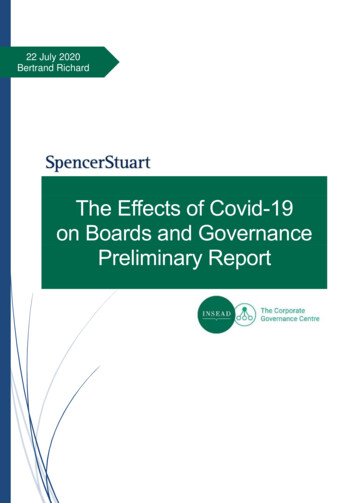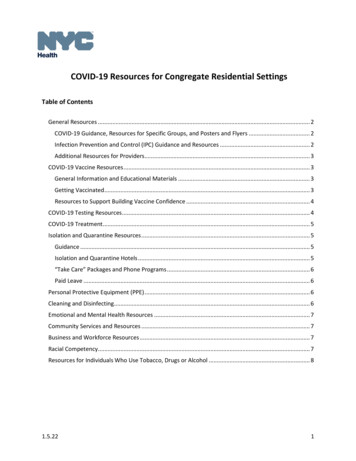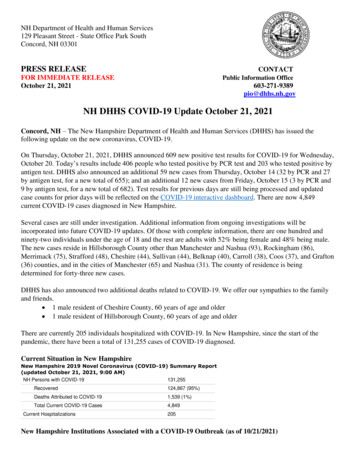
Transcription
22 July 2020Bertrand RichardThe Effects of Covid-19on Boards and GovernancePreliminary Report
ContentsIntroduction: Purpose of this Survey . 2I.Executive Summary . 3II. Covid-19 and Risk Mapping. 6III. Covid-19 and Board Functioning . 9A) Board behavior . 9B) Relation between the Board and the management . 13C) Information of the Board . 16D) Effects of Covid-19 on Leadership . 18E) Effects on communication . 20IV. Boards’ response to the crisis . 22Appendix . 251
Introduction: Purpose of this SurveyIn the context of an unexpected event such as the Covid-19 crisis, boards entered unchartedterritory and, with management, had to show their ability to overcome a crisis of an unprecedentedmagnitude.To understand how the boards reacted, INSEAD and Spencer Stuart launched a survey of 2,000board members mainly based in Europe.The present report outlines the initial findings and covers the following:-What are the lessons for boards of directors?Risk mappingCrisis managementBoard role and leadership2
I.Executive Summary1) Covid-19 severely challenged the risk and crisis management of manycompanies.---It was the first time that an external event triggered a combination of risks which werepreviously considered as independent:1. Health and safety2. Discontinuity of supply3. Decline of stock price4. Drop in sales5. Treasury gapEconomies were not impacted by the pandemic per se but by the decision of governmentsto control the pandemic through a global lockdown, which had an immediate impact onthe level of activity of the worldwide economy.In some cases, the top management was also physically impacted and consequentlyunable to play its role, which could have not been considered in the matrix of risks.Crisis management ability was tested in real life with potential lethal consequences forsome companies.2) Covid-19 consequences differed between industries with those severelyimpacted (airlines, travel, automotive, retail) and those benefiting from thelockdown (GAFA, food). All companies were not equally positioned in the fightagainst Covid-19.3) Covid-19 amplified the strengths and the weaknesses of Boards andmanagements. Some entered the crisis in better shape than others and werebetter prepared to fight thanks to efficient governance. Some revealed eithertheir potential or their fragility in dealing with the crisis.4) Covid-19 was a real acid test of:-Board cohesion and solidarityThe trust the Board has in the management’s ability to deal with a crisisThe self-control and maturity of the Board and the managementThe efficiency of its crisis management tools and processesThe ability to seize opportunities, for example, by taking over competitors in troubleThe robustness of succession planningThe employees’ engagement3
5) This global crisis had two meanings for Boards and managements:--One being danger:1. Protecting the balance sheet and the activity;2. Taking care of its people and securing the permanence of the management;3. Piloting the stock price, profitability and liquidity;4. Taking care of clients and suppliers and securing the supply chain;5. Protecting against raiders;6. Managing potential conflict between the interests of the company and the interestsof the shareholders.One being opportunity to be overseen by the Board in a second phase:1. After making sure that the company knows how to adequately react, anticipatingthe changes that the crisis will require going forward;2. Preparing the crisis exit;3. Taking advantage of the opportunities presented by the crisis;4. Rethinking the business model, the purpose of the company and the strategy.6) Covid-19 highlighted what makes a board successful in dealing with such acrisis:---Permanently challenging its crisis management processes by thinking the unthinkable andusing scenario analysis rather than only relying on existing processes.Testing the behavior of the board in its ability to work under stress and deterioratedworking conditions:1. Focusing on the immediate issues without getting lost in details;2. Staying unified and ensuring consistency of the overall decisions between theshort term and the long term;3. Working efficiently with the management with an adequate and clean division ofresponsibilities between the two bodies without overloading the former withunrealistic demands of the latter, slowing down the decision process;4. Getting used to working remotely with secured communication facilities;5. Celebrating success of the management;6. Reimagining the future.Having clear leadership at the board level which means a chairman really playing his rolebut only his role;Establishing adequate communication within the board and between the board andmanagement, the external communication of the company remaining a management duty;Providing emotional support to the management and to the employees and beingsupportive. Assessment of the performance will come later – crisis is not the right time tochange the CEO;Making sure that in dealing with the crisis, the management remains consistent with thecompany’s values.4
7) Covid-19 highlighted what makes a successful chair, one who:--Must always be prepared to guide the board through the unexpected. Even if the crisiscould have been foreseen, the response to it was not;Should provide emotional support to the CEO and the management team by avoiding asituation in which board members bother them with unnecessary demands, and makesure that they focus on the right issues. The role of the Chair is to help raise the game ofthe executives;Should show real self-control and ability to calm the debate when the company is putunder stress;Should make sure that the Board stays united and that no Board members are left behind;Should make sure that a well-articulated and compelling purpose is defined by the Board.8) What are the lessons for the future?---The Board should revisit the robustness of its processes1. In terms of Board operations in: Giving a clear mandate to the management by clearly defining the divisionof roles with the board Challenging the risk mapping and the scenarios of the future Running an emergency plan Working under stress Creating a safe space for the management without negative emotions Planning potential successions Operating new communication channels with high security standard2. In terms of relations with the shareholders and stakeholders Shareholder support (dividend policy) Protection against raiders Relations with employees3. In terms of business model, strategy and succession planning: frame the postcrisis strategy to safeguard the futureThe Chair’s performance in dealing with the crisis should be assessed on his ability to:1. Align the board and the management2. Position the board at the right level and keep it united3. Support and help the CEO4. Keep an eye on the futureThe Board should support the management during the peak of the crisis. Analysis of hisperformance will come later.9) In conclusion, the crisis challenged the Board more on its attitude than on itsrole and duties.5
II.Covid-19 and Risk Mapping“The total collapse was not in our risk mapping.”16%50%34%YesYes, butNo49%26%25%YesYes, butNo4%13%Very low40%43%LowAverageHighDid the risk mapping preparedfor the board take intoconsideration this type ofcrisis?Did the board consider theprobability that various risksmight emerge together as hasoccurred with COVID-19 ?Expected probability ofoccurrence of a pandemic-Even if most of them were comfortable with their risk mapping, 84% of Boardsacknowledge that they did not envisage such an economic crisis caused by apandemic, because it was identified as a low probability health risk. It was not seen as apotential economic risk because no one thought that it would lead to a global lockdownwhich stopped most of the world’s economies.-Amongst those that considered it more seriously, most of them had operations inAsia where they had to deal with SARS a few years earlier and were able to betterunderstand at the early stage what was happening in China.-Macroeconomic, financial crisis, operational and market risks were taken intoconsideration but never linked to a pandemic. The various risks were mainly identifiedseparately instead of in combination, and the emergency plans were not designed to facethem simultaneously.-The speed, the magnitude of propagation and the scale of the pandemic wereunderestimated and were a surprise for most of the Boards. Even if many companiestested their operational resilience, none of them expected such a high proportion of staffunable to go to work; consequently, the business continuity plans were not able toaddress an issue of this scale.“While we always prepare for simultaneous risk occurrence, the scope and magnitude of thiscombined economic and pandemic crisis was unprecedented and required adjustment as themagnitude and scope moved across the globe. The pandemic impacts allowed lessons learned tobe transferred from our region to a new impacted region as it emerged.”-For instance, the non-access to plants and the failure of suppliers to deliver wereconsidered on a country basis or at most on a regional basis but never globally.-Some companies which had recorded a pandemic as a potential risk for many yearsstopped considering it because it had never occurred, and thus were taken bysurprise when it did.6
-The lockdown was a real-life test for IT systems, which had to support remote waysof working with all the consequences in terms of telecom capacity and cybersecurity.Since the pandemic was a low-probability event, the global impact wasunderestimated by most of the companies, although they felt that their risk andcrisis management procedures were globally adequate.-“We need to focus more on impact and how to react than only on the description of the risk.”“Procedures were not fully adequate, but management and team reacted quickly on priorityissues.”8%9%26%Yes66%Yes, butNoAdequate68%Yes, butNoOperationalIn the face of COVID-19, would you say that theexisting crisis management procedures wereadequate and operational enough?-21%Yes24%52%27%YesYes, butNoThe management24%49%YesYes, but28%NoThe audit (or risk)committeeIn light of such an experience, would you say that theboard should have challenged more candidly the wayrisk and crisis management were handled bymanagement and audit (or risk) committee?Risk management procedures were generally in place, but the crisis managementprocedures and continuity plan had to be adjusted in view of the magnitude andcomplexity of the crisis. The question was not whether the company had the rightprocedures but how it reacted and adjusted them. Most of the interviewees wereimpressed by the agility and the responsiveness of their management.7
Learnings on Risk Management-Only very few companies seriously took into consideration the economic consequencesof a pandemic because nobody expected to have so many risks simultaneouslytriggering and to have governments ordering a global lockdown and companiesordering plant closings for such a long period of time as an answer to the pandemic.-The best prepared companies were those having dealt before with the SARS pandemicand those whose operations in China helped to detect the initial signals of the crisis.-Most of the Boards are quite happy with how the crisis management was handled bytheir management since, even if the scenario was different from reality, they showedgood agility to adapt.-The key lessons of this crisis are:1. Risk mapping, crisis management and business resilience will have to bereconsidered in light of past events and now building crisis scenariosassociating different risks will become critical, taking into account the impact ofsimultaneous events and interconnections.2. The best way to survive is more in the speed of reaction than in the ability toforecast the right events.3. The world is much more connected and interdependent than was generallyconsidered, which should be taken into account in risk management.4. Take a holistic risk assessment and management approach to complement thesilos and bottom up approach mainly used to date. Risk analysis should be lessbased on models and more on common sense, macro-economic and politicalanalysis by accepting that the future is never the simple repetition of the past.Scenario planning should be the new methodology to prevent and respond tounforeseen crises.5. In crisis management, agility and reactiveness appear to be more efficient thanonly preconceived processes. Facing unforeseen risks, Boards andmanagement should train themselves on how to react when taken by surpriseand list the best practices tested during this Covid-19 crisis.8
III.Covid-19 and Board FunctioningA) Board behavior-Boards reacted very quickly to the crisis, half of them taking action within a week,the others taking a few weeks but less than a month and in most cases, the reaction wasinitiated by the management with the support of the Board.How long did the board take to realize themagnitude of the crisis?3%The managementLess than a week49%48%Who was the first to react?37%Between a week and amonthMore than a monthThe board60%3%Bothsimultaneously“Thanks to a fluid interaction between board and management, the former was quickly involved inthe decision process”“Ad hoc Board meetings were called, and Board members made themselves available”“United in inaction except for the safety aspect, apart from a couple of non-execs with deepcorporate crisis management experience”-Boards had to take difficult decisions, with not all Board members always agreeing butwhen the decision was taken, solidarity became the rule.“The management took the lead in the operational and financial aspects of the crisis as it shouldhave in a time of required agility and reactivity, with the Board keeping a more long-term view.”-Thus, despite its magnitude, the crisis did not break Board unity, with no significantdifference of opinion between local and foreign Board members. In some cases,international Board members had a more global view and realized more quickly themagnitude of the crisis.9
Did you notice a difference of reactionbetween local board members andforeign board members?7%7%Yes86%Yes, butNoIn dealing with this exceptional situation, did theboard Stay united1%5%Split in different camps94%Diverge between thosebecoming very involved andthose becoming distant“Foreign board members were more conscious and also more demanding on proactive steps withhigher sense of urgency”“The Board stayed united, constructive and supportive of the management who was fully incommand, even if appreciation of their impact could differ amongst members”“The French and Italians reacted faster”“US Board members were still behind the curve”“Difference of reactions is not perceived as a disadvantage but as enrichment”“Divergence could have occurred but not on the way to deal with the situation”-Committee members, such as those on the Audit and Risk committee, were moreinvolved due to their expected role.-In a few extreme cases, when the survival of the company was at stake, somepeople may have distanced themselves to protect their reputation if they found thesituation too risky, but this was the exception.-From the perspective of their colleagues, employee representatives behaved moreas Board members than as employees, even if they were very concerned by thehealth consequences of Covid-19.10
How did the employee board members react?22%As board memberAs employee78%“Our employee representatives were very professional and collaborative in the way theybehaved”“Their two main concerns were health safety and protection of the company, in that respect, witha focus on dividend reduction”11
Lessons on Board Behavior-In most cases, the Board and the management were quick to react and stayed united indealing with the crisis. Except in very specific cases, management were supported byBoards, and the crisis was not perceived as the time to change management.-A very large majority of Board members stayed very supportive of the managementbecause the latter kept them very well informed from the early stage of the crisis. Thecooperation was constructive and efficient, and most Board members found that teamspirit improved during the crisis.-Risk and Audit committee members were naturally more involved than the othermembers.-There was no real difference of attitude and reaction between local and foreign Boardmembers in dealing with the crisis. Board members with strong international experiencemay have been quicker to understand the consequences. However, it appears that theSouthern Europeans were more sensitive to the consequences of the crisis than theNorthern Europeans or the Americans. This could be explained by the fact that thecrisis was more serious in this part of the world when the study was completed.-In dealing with the crisis, the diversity of the Board composition was clearly seen as astrength, because the sensitivity to the situation was not the same from one region toanother.-Employee representatives behaved very professionally, keeping at the forefront of theirminds the health and safety of employees and the protection of the company.12
B) Relation between the Board and the management-In most cases, the cooperation and relations between the Board and themanagement were reinforced by the crisis through more contact and more opendebates on the consequences of the crisis and the answers to be given.Was there a change in how the non-executive board and the management related toeach other ?14%8%78%YesYes, butNo“Being a team is critical to weathering such storms. Team spirit with the management was builtduring peaceful times and reinforced through open debates during the crisis”“With more frequent interactions, we ensured that the management felt properly supported, andBoard members comfortable with the decisions taken”“No change in the style but a lot of new questions based on the operational management of thecrisis”-Some boards became more hands-on and less strategic although some othersmade sure to keep an eye on the future when the management was dealing with theday-to-day operations.-The number of Board meetings, which were all held by videoconference, increased,and the peak was reached in April, followed by a return to normal in June.13
Did the number of meetings increase?How were the meetings held ?9%17%2%In personYes8%By videoconferenceYes, butNo75%By phone only89%How many meetings were held in:0%February 202020%8%March 2020 4%40%60%80%66%35%100%20% 3% 3%34%15%No meeting11%1 meetingApril 2020 5%30%32%15%2 meetings18%3 meetingsMore than 3 meetingsMay 2020 5%June 2020-12%41%31%52%12% 10%25%7% 4%58% of Boards did not appoint any specific task force to deal with the crisis,considering that one of its inherent duties, and believing that appointing a taskforce would complicate the process with the management. 27% created a specifictask force, and 13% appointed the Risk or the Audit committee to deal with it withoutspecifically extending the role of the committee.Was a specific task force created formonitoring the plan or was it attributedto one of the committees?Did the committees extend their role,taking on new responsibilities/tasks?Specific task force created27%58%7%5%3%Task assigned to the riskcommitteeTask assigned to the auditcommitteeTask assigned to thenomination committeeTask assigned to thestrategy committeeNo specific task force14%6%YesYes, but80%No14
“A task force was created at management level and not at board level”“The Board did not create a specific committee, but the management did”“The Board felt that it should directly deal with the crisis but with all its members involved”“Work was spread across all committees according to their expertise”“The full Board remained in charge of overseeing the action taken by the management which wasclearly on the front line”Learnings on relations between the Board and the management-In most cases, the crisis strengthened the relation between the Board and themanagement who stayed united to face it, with a more engaged Board (more meetingsand more communication).-The lead was clearly and normally taken by the management with clearly statedsupport, a stronger engagement from the board and more detailed reporting from themanagement.-When there was divergence between Board and management or when the Board feltthat the management was not adequately answering the problems, the change ofmanagement was not the favorite response of the Board because it could have causedadditional damage. The decision was postponed to better times.-A majority of Boards did not delegate to a specific task force or to one of its committeethe task to deal with the crisis because this was considered a duty of the full Board.15
C) Information of the Board-The management immediately understood that in such a context, Board membersneeded to receive adequate information and without distinction amongstthemselves, whatever their roles were.Was the management conscious of theneed for specific additional informationby the board members?3%10%How did the board to secure its access toinformation?4%Internal, through themanagementYesYes, but87%NoExternal throughalternative resources96%“The Board had to figure out the impact of the crisis on: Employee health, Sales, Treasury andliquidity, Profitability, Contingency plans”“All the Chairman’s reports to the Board, regular updates on the situation were sent by mail”-The specific information which was shared with board members included, forinstance:1. Weekly reports on the health of staff, treasury, operations, logistics, sales, risks,plant closures2. Scenarios and stress tests on P&L, treasury and liquidity with their impact onstrategy3. Evolution of the situation, country by country4. Continuity plan5. Cybersecurity on communication-Many Boards were keen not to overload management with too many demands orquestions, especially because they felt they had no real problem being kept informed.Did the board have challenges accessinginformation?5%5%YesYes, but90%NoWere you satisfied as a board member bythe way you were kept informed?4%2%Very satisfiedSatisfied43%51%Slightly unsatisfiedVery dissatisfied“The management being fully dedicated to solving the problems generated by the crisis, ourconcern was to not distract them. So, we did not ask for more information than in normal time”16
-All Board members were treated equally in terms of access to information by themanagement and the Board members mainly relied on the information provided bythe management they trust.Their role25%60%15%YesYes, butNoDid some board members receive moreinformation than others?3%15%1%Their nationality81%Their locationTheir status(shareholder, )And if so, what was the differentiating orexplaining factor?Learnings on how Boards were kept informed-Management quickly understood that the Board must be kept precisely and regularlyinformed on the short-term impact of the crisis.-The large majority of Boards did not have problems accessing information.-Reports were done weekly or biweekly along with an increase in the number of Boardmeetings.-Boards were keen to receive scenarios, stress tests on the activity, and reports onemployee health and protection.-Boards were also keen not to overload management with too many informationrequests, the priority being to let the management do its job.-Board members were treated equally in terms of access to information provided bymanagement, which they candidly trusted.17
D) Effects of Covid-19 on Leadership-The crisis management did not bring any change in leadership between the Board andthe management. The division of roles was not challenged, there were just moreinteractions, more work for both, and more involvement of the Chairman incommunicating with Board members.Did the split ofresponsibilities assigned tothe management and to theboard change under COVID19 pressure?7%4%12%YesYes, but89%Did a group of boardmembers take the leadwithin the board ?No4%YesYes, but84%Did the managementchange its organizationand/or structure to adapt tothe new situation?No27%63%10%YesYes, butNo“There were more shared responsibilities between the Board and the management”“The crisis had more impact on the functioning of the leadership team than the Board with, inmany cases, the set-up of a crisis taskforce which may have changed the ExCo rules offunctioning”“The management organization was flattered”-Committees were more solicited, especially at the beginning for the Audit and Riskto assess the impact of the crisis, and then for the Strategy committee when theBoard had to assess the impact in the long term.-When a CEO transition was already underway, the crisis was an acid test of thesuccessor’s ability to take the reins and be immediately operational and relevant.-When a war room was created to deal with the crisis, it was done at managementlevel and not at Board level, which is consistent with the normal division of rolesbetween management and supervisory duties.18
-In a few cases, the role of chairman was expanded, mainly for communicationmatters and teamwork with the CEO.Was the chairman’s role extended to newareas?10%6%Did the chairman oversee a change inrelationship between the board and themanagement ?Yes84%NoYes29%Yes, butYes, but64%6%No“The Chairman was more involved in communicating with the rest of the Board and withstakeholders than in normal times”“The Chairman was continuously kept informed and closely followed up decisions taken”-Within the Board, there was no real change of leadership and no significantincrease of authority of senior or influential members, even if those having alreadygone through crises were listened to more, and committees’ chairmen were moreinvolved.Learnings on leadership-The crisis did not really put more stress on the balance of power and roles within theBoard and with the management even if the Chairmen and the committee chairmen hadto be more involved and present.-The only change was closer communication between the Chairmen and the CEOs andbetween the Chairmen and Board members.19
E) Effects on communication-The need to inform Board members on the crisis combined with the lockdown,required Boards to adapt their communication tools with:1. a switch from physical to virtual meetings;2. an increase of the number of meetings, which differed from one company toanother, ranging from weekly for some to only monthly for others;3. a regular flow of information sent through the usual internet communicationsoftware used by Boards (Board Notes, Diligent, Board Vantage, Brainloop, etc.);-The main communication tools used were:1. Conference calls;2. Video conferences;3. MS Teams;4. Skype;5. Webex;6. Zoom.-One of the challenges was to provide high security standards and protection forthose communications, some companies using secured lines.-The communication plan was led by the CEO and the management in coordinationwith the Chairman and without a specific appointed external advisor.Who led the communication plan?Did the company appoint a specificadvisor to pilot the crisis communication?7%7%1%The CEOYesThe boardYes, but90%-92%NoHalf of the Boards initiated direct contact with their shareholders to keep theminformed and get their views while only 30% did the same with proxies.Did the board, through its chairman or SID undertake direct contact:With shareholders?45%7%47%YesYes, butWith proxy?25%5%70%No20
-Communication with stakeholders (employees, banks, administration) wassystematically and directly conducted by the management. Reassuring employeeswas at the top of the agenda.Learnings on communication-Boards met more often but virtually, due to the lockdown.-The development of new communication tools necessitated enhancement of theirsecurity to protect confidentiality.-The external communication of the company was handled by the management withvery little interference by the Board.-The communication with stakeholders, especially with employees, banks and financialmarkets, was handled by the management.-Only 50% of companies engaged in direct contact with shareholders.21
IV.Boards’ response to the crisis-¾ of Board members were satisfied with the timeliness of receipt from themanagement of the right set of scenarios and action plans. Such scenarios andplans were constructively challenged but did not justify the appointment of adedicated consulting firm.Did the management presentto the board the right set ofscenarios, planning and actionswithin the expectedtimeframe?5%14%81%YesYes, butNoThe timeframe was.4%1%4%45%51%Did the board appoint adedicated advisor(s)?Very quicklyQuickly95%SlowlyYesYes, butNo-Based on their own experiences, Board members mainly challenged themanagement on:1. Employees’ health and safety;2. Continuity of services and consequences of the lockdown;3. Protection of cash position and balance sheet, and stress test on liquidity andsolvability;4. Conditions to restart business operations at the end of the lockdown;5. Impact on long-term strategy.-This ability to constructively challenge was a key differentiator amongst Boardmembers. Some of them focused on worst-case scenarios in order to increase theawareness of the management.“Generally, Board
impacted (airlines, travel, automotive, retail) and those benefiting from the lockdown (GAFA, food). All companies were not equally positioned in the fight against Covid-19. 3) Covid-19 amplified the strengths and the weaknesses of Boards and managements. . -The lockdown was a real-life test for IT systems, which had to support remote ways











